At the professional level of football today, the way that clubs recruit players has changed dramatically in the last 5-10 years. We do not have to go back far to a time when recruitment at top clubs was built in the main on relationships with agents or coaches, essentially driving a club’s recruitment strategy. Now, the increasing use of data and video as a part of the recruitment process has opened the game up to clubs and allowed those willing to adopt more modern methods to create an edge over their more traditional opponents. Using data as a step in your recruitment process, in particular, has emerged as an opportunity for clubs to understand various markets that may not have been readily accessible previously.
In this article, we will use data analysis techniques to identify interesting players currently playing in 2. Bundesliga, the second tier of German football. Not all of the players that we have selected are necessarily young or under 23 years of age, but often when writing or researching these types of articles, we can effectively ignore players who are older as we are under the impression that clubs are only interested in recruiting young talent. This simply is not the case, and in my experience, the driving factor behind most teams’ recruitment strategy tends to revolve around fit and then how suitable the player is to the buying team’s game model and style of play.
We use event data in this article in three stages. Firstly, we use a zoomed-out approach in order to identify interesting players in set positions using two distinct parameters. This is done in the form of scatter graphs that allow us to quickly and efficiently visualise data relevant to the position of the players we are looking for. The next step is to use a pizza chart to give a more in-depth view of the player that we have selected, and finally, we will use event maps to visualise specific aspects of the player’s outputs.
Can Uzun, 18 years old, Attacker, Nuremberg and Turkiye
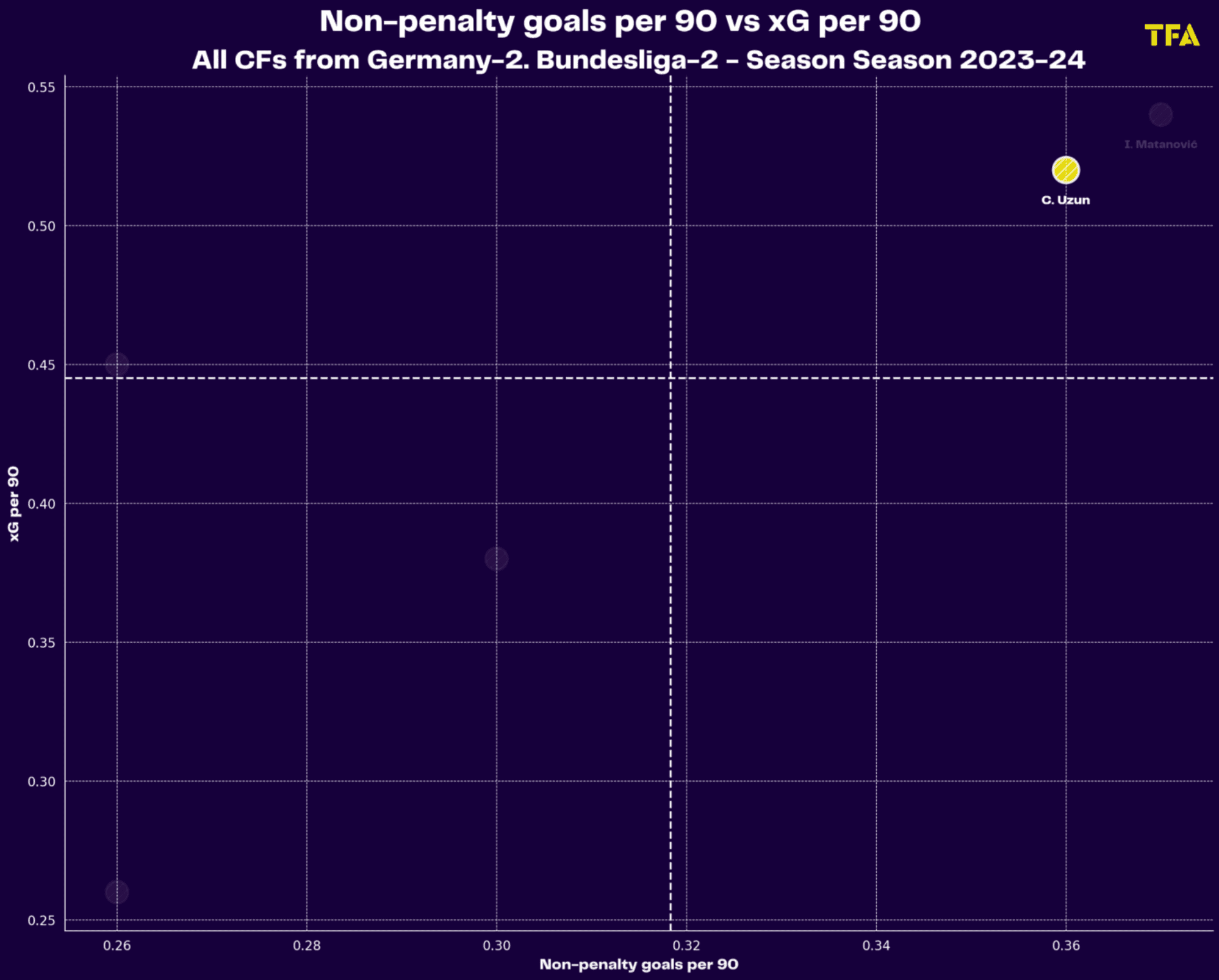
Firstly, I decided to look to identify interesting attacking players, and at the moment, in terms of potential, at least there is one player who really stands out in the 2.Bundesliga. That player is the 18-year-old Turkish U21 international Can Uzun of Nuremberg. The young attacking player is equally comfortable when asked to lead the attacking line as a 9 and when playing as a 10, whether from the same line as the striker or tucked in behind in order to link together the lines of the midfield and the attack.
Although he has, for now at least, chosen to represent Turkiye at the international level, he was actually born in Germany. He initially played for Ingolstadt before switching over to join the youth system at Nuremberg in 2020. Despite only 18 years old, he has firmly established himself as a first-team regular at the club in the German second tier, and so far this season, he has scored 12 goals in 21 appearances in 2.Bundesliga. He has also started to attract the attention of some of the biggest sides around Germany and Europe.
The scatter chart above shows non-penalty goals per 90 along the x-axis and xG per 90 up the y-axis. As you can see, Uzun has been performing well on both counts and is firmly established in the top-right quadrant of the scatter.
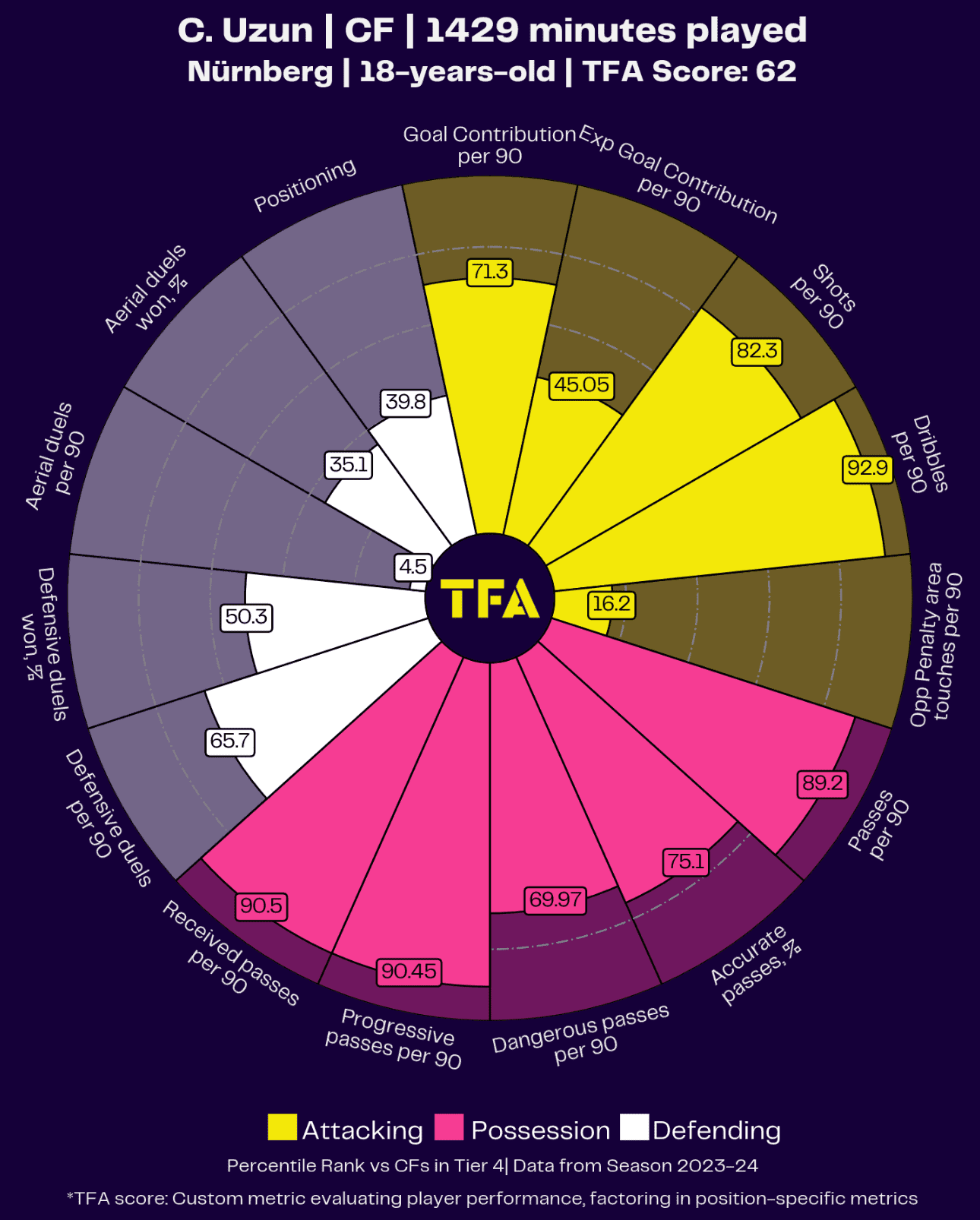
When we then drill further down into the performance data from Uzun so far this season we can start to clearly see why he is so highly rated by those in the game. The pizza chart shows a players performance via percentiles compared to other players who have been playing in the same position. Uzun, in 1429 minutes in 2. Bundesliga is in the 71st percentile for goal contributions (goals + assists) and the 45th percentile for expected goal contributions (xG + xA). While his actual performance is currently higher than his expected performance, which can sometimes be a concern, the rest of his underlying attacking performance is very high, and he is in the 82nd percentile for shots per 90 and the 92nd percentile for dribbles per 90.
As well as being effective in the attacking phase, he is also a creative forward player who performs exceptionally well when it comes to passing and ball progression. As you can see, he is in the 89th percentile for passes per 90 amongst central forwards, but he is also in the 69th percentile for dangerous passes (passes to the final third and the penalty area) and the 90th percentile for progressive passes.
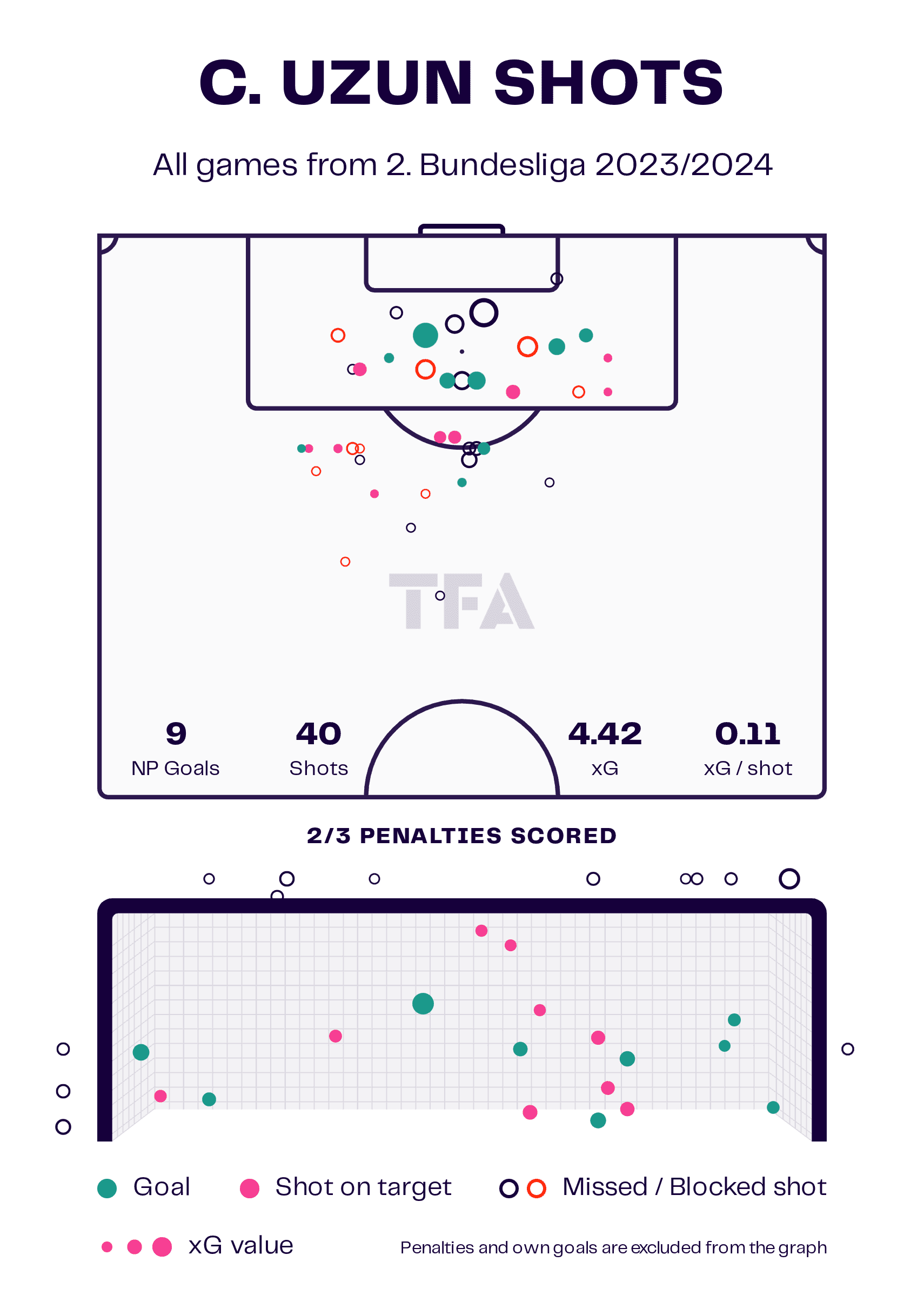
Now, we can drill down further into the shot map for Uzun so far this season in the 2.Bundesliga. While there are still some shots from outside the area, we can clearly see that he does his best work as a striker in the width of the opposition penalty area. His movement and positional awareness when working around the edges and into the penalty area is generally excellent. As a result, he gets into good goalscoring positions in central areas. He can create separation from opposition defensive players with his movement in tight areas and timing.
There is little doubt that Can Uzun will be moving on from his current club and from the second tier this coming summer. The only questions are around where he will move to and how big the fee will be to get the young Turkish forward to your club.
2. Matthias Zimmerman, 31 years old, Full-back, Fortuna Dusseldorf and Germany
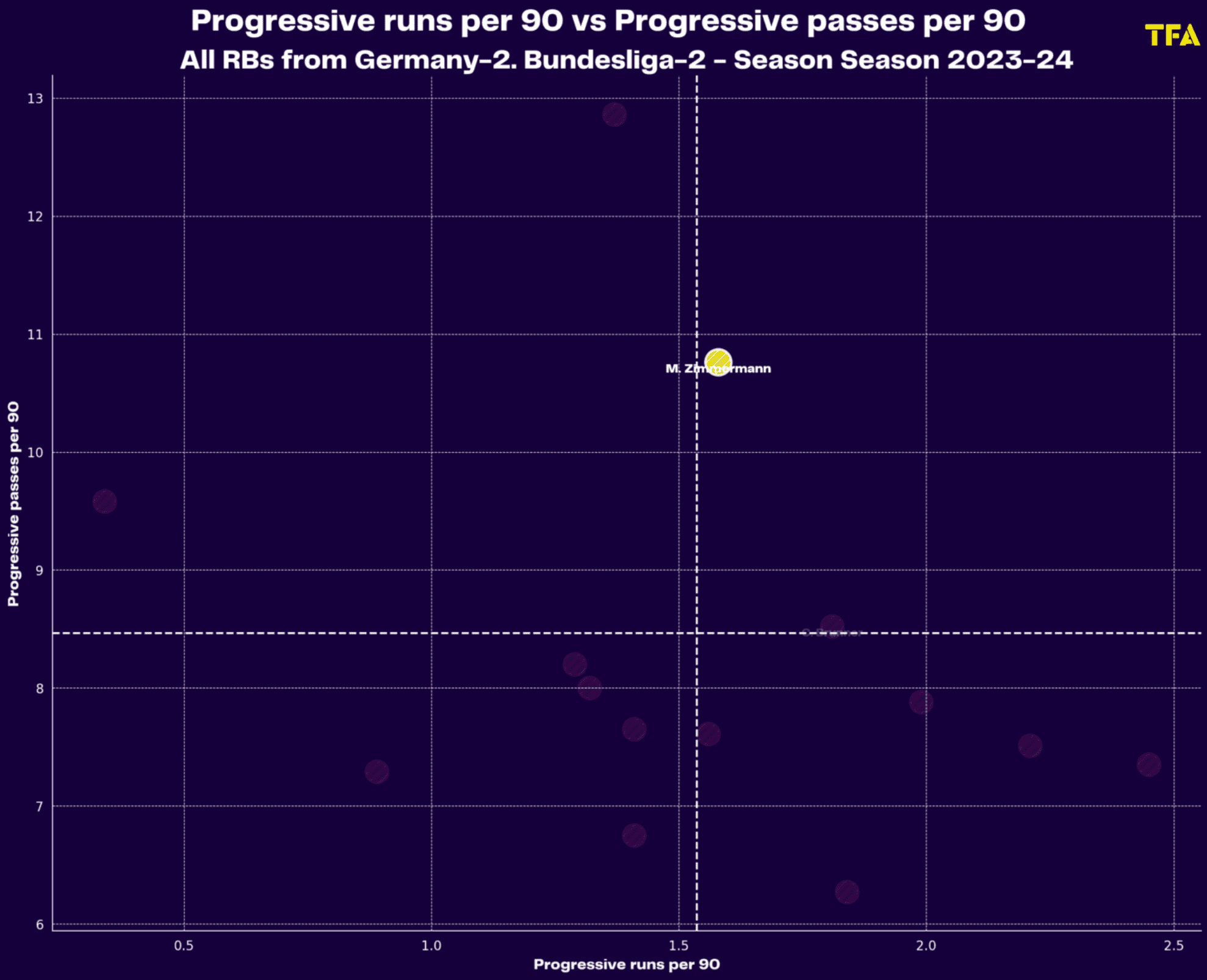
From a young attacking player, we will now transition to a full-back who is at the latter end of his career. Matthias Zimmerman is a 31-year-old German right-back who is currently playing for Fortuna Dusseldorf in the second tier. Earlier in his career, Zimmerman represented Germany up to the U20 level but never progressed beyond that point at the international level. Throughout his career, Zimmerman has played for some of the biggest and best-established clubs in German football, having played for Karlsruher before moving on to represent Borussia Monchengladbach and then Stuttgart before joining Fortuna Dusseldorf on a free transfer in 2018. He is actually out of contract at the end of this coming season.
The scatter graph above is designed to highlight full-backs who are progressive in their nature with progressive runs along the x-axis and progressive passes per 90 up the y-axis. Once again, we can clearly see that Zimmerman is performing well in both metrics and again, he is in the top-right quadrant.
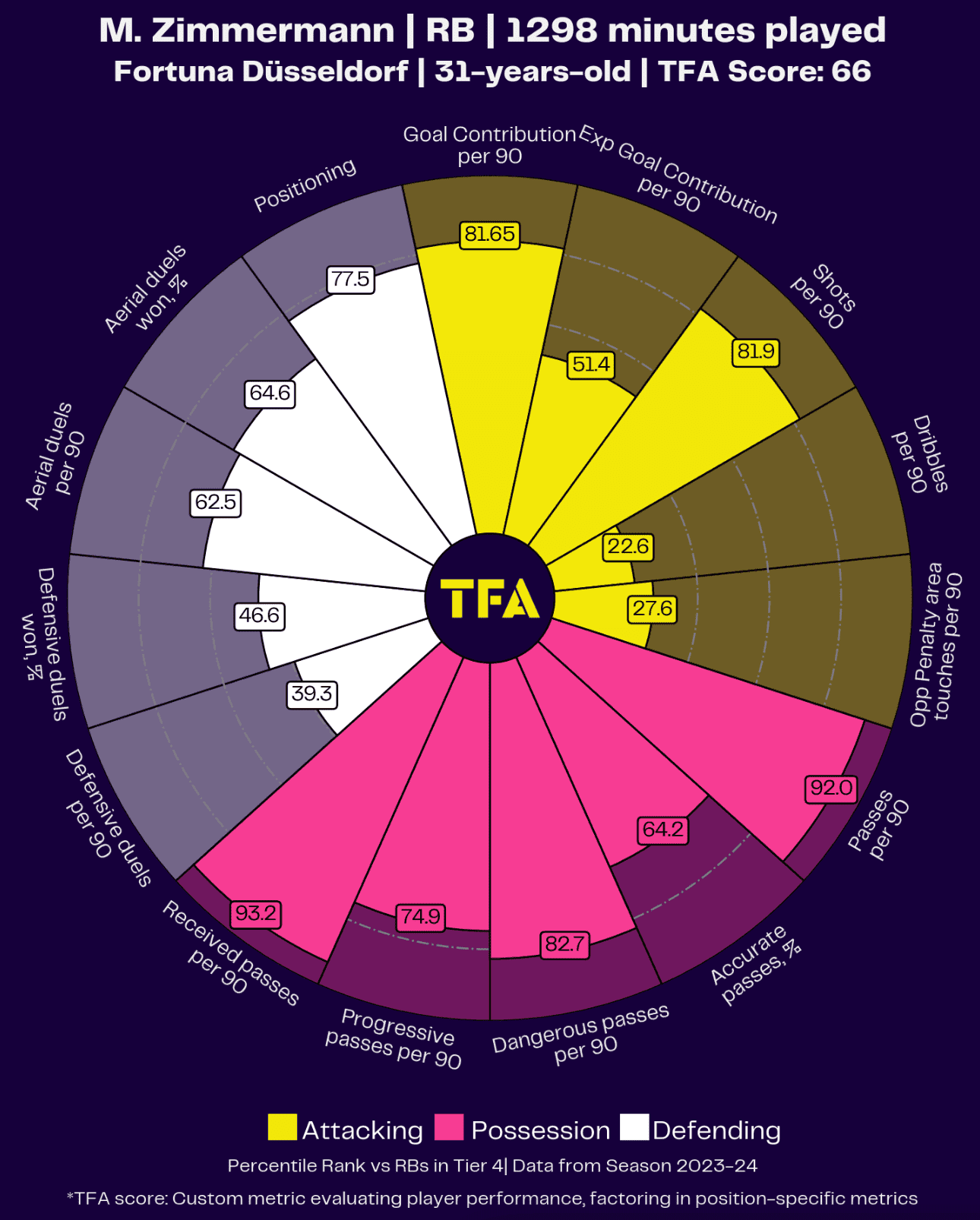
When we start to drill further down into his performance via his pizza chart, you can clearly see that he has a balanced profile across all three key areas of the game. In the attacking phase, he actually contributes effectively compared to other RBs in 2. Bundesliga, and he is in the 81st percentile for goal contributions and the 81st percentile for shots per 90. In possession, we have already seen from the scatter graph that he is progressive, but he also has good volume to his passes, and he is in the 92nd percentile for passes per 90, but as you can see, he is also in the 82nd percentile for dangerous passes and the 74th percentile for progressive passes. He has also been impressive for a right-back so far this season in the defensive phase, and he is in the 62nd percentile for aerial duels and the 64th percentile for the % of aerial duels he has won. He is also in the 77th percentile for positioning.

When we look at the map of progressive passes for Zimmerman so far this season in 2. Bundesliga, you can see that he is effective from the wide areas in terms of moving the ball forward for teammates into the final third. Interestingly, when he is in the final third, he creates a threat from the half-spaces when progressing the ball and playing into the opposition penalty area.
Given that Zimmerman is out of contract at the end of the season, he represents value and opportunity for clubs, even in terms of moving back up into the Bundesliga. Otherwise, it is easy to see him making the move across to play football in the MLS.
3. Jannis Nikolaou, 30 years old, Midfielder, Eintracht Braunschweig and Germany
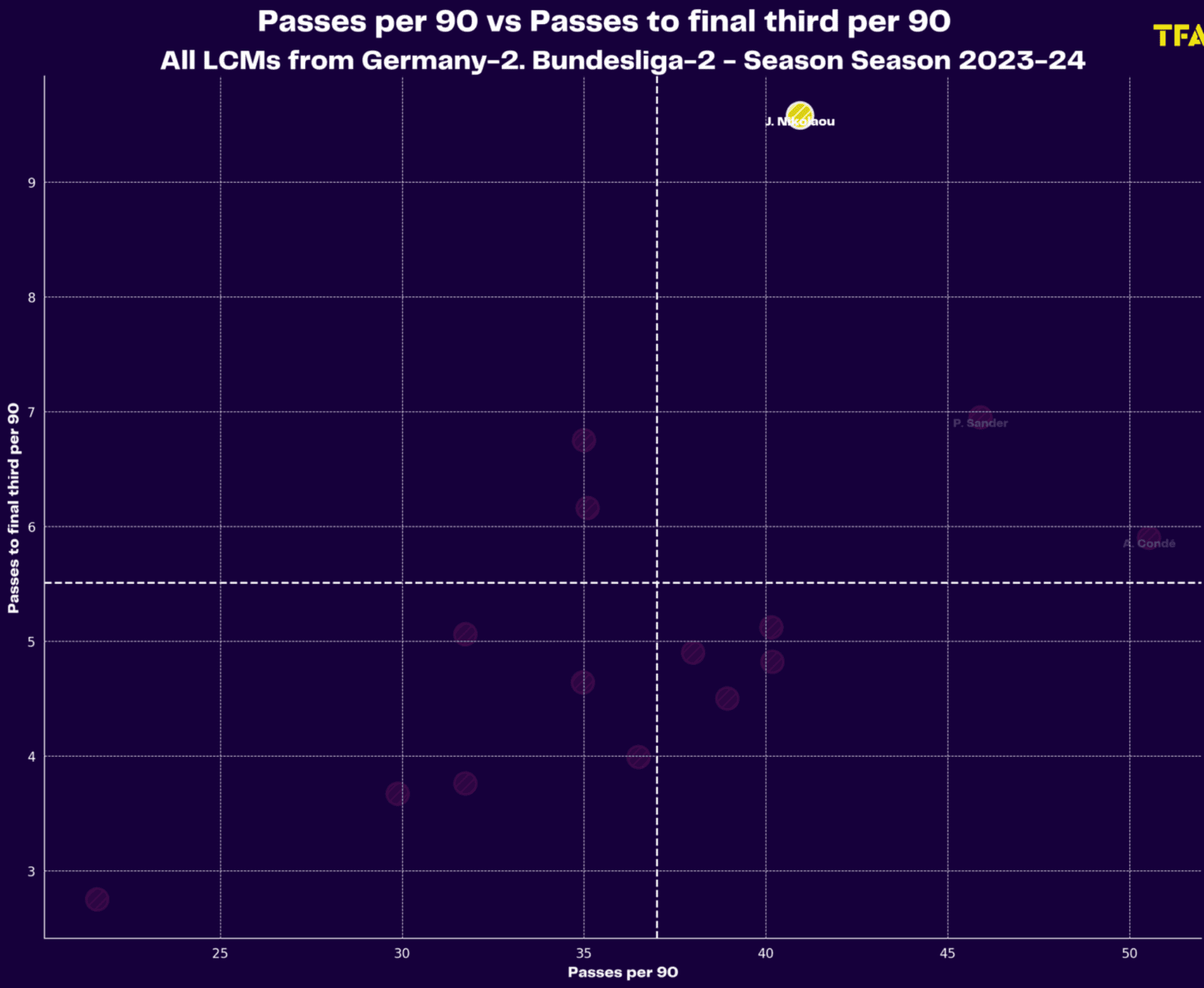
The final player that has been selected for the article today is another that might be considered to be towards the end of his career at 30 years old, but he is also a midfield player who is currently playing at a high standard in terms of his passing and ball progression from the centre of the pitch. He is currently the captain of Eintracht Braunschweig, having been at the club since 2020. He had previously played for Koln and Dynamo Dresden, but the majority of his career has been in the second tier of Germany. He is a defensive midfielder of 6 who is extremely capable when it comes to progressing the ball through lines. The scatter graph above shows passes per 90 along the x-axis and passes to the final third up the y-axis, and once again, we can clearly see that he has good volume to his passes and is a progressive player in possession.
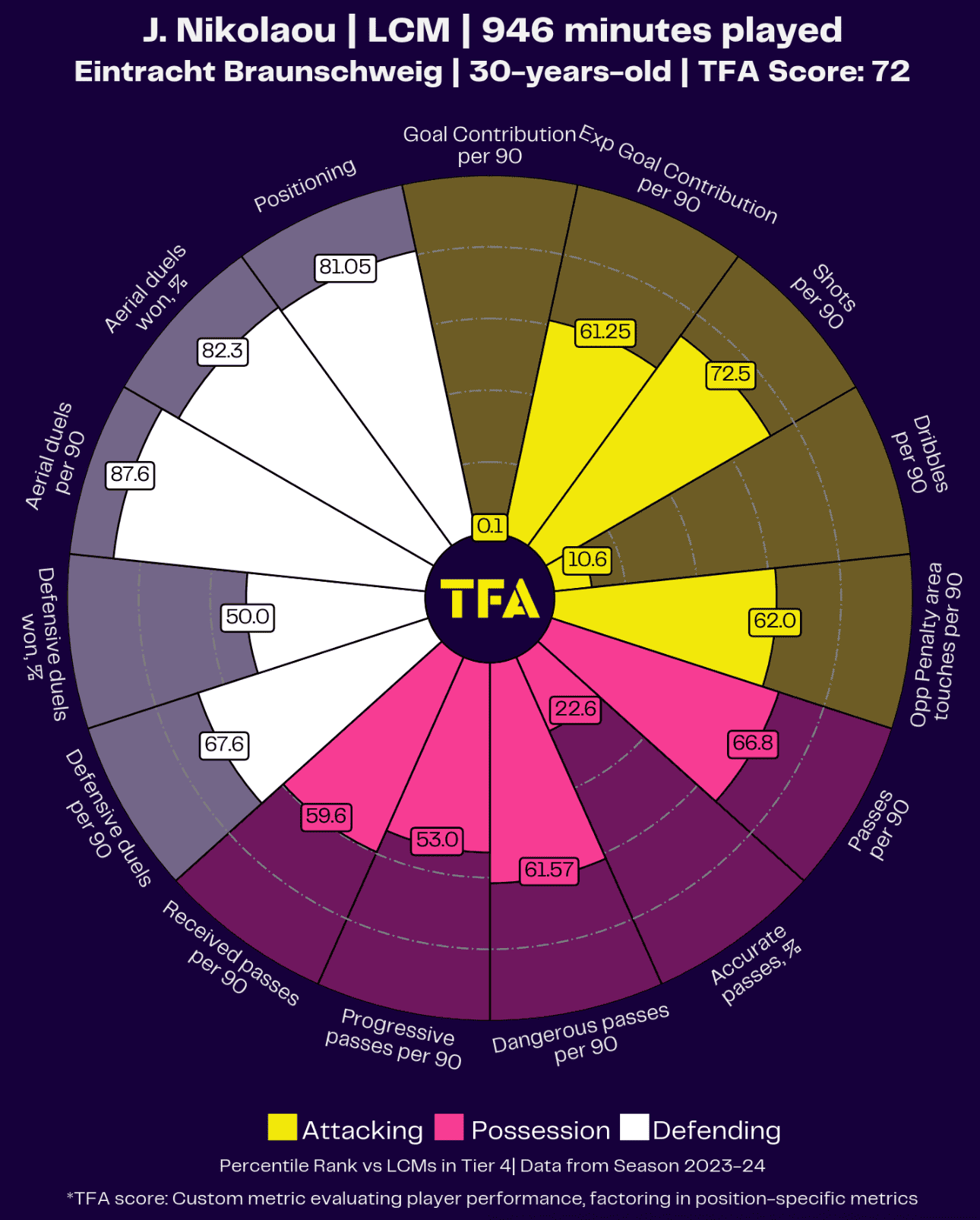
Drilling down further into his performance data, we can see that Nikolaou is at his best in the defensive phase of the game. He is in the 66th percentile for passes per 90, 61st for dangerous passes, and 53rd for progressive passes per 90. In the defensive phase of the game, however, his performance so far this season has actually been very strong. He is in the 67th percentile for defensive duels per 90 and the 50th percentile for the % of those duels that he has won. He is also in the 87th percentile for aerial duels won and the 82nd percentile for the % of those that were won, and finally, he was in the 81st percentile for positioning.

As you can see from the pass map for Nikolaou this season, he tends to play for the most part from the left side of the pitch, with his passing typically going into the half-spaces on the left side.
As with Zimmerman, there is some value for sides in a player with Nikolaou’s profile, although the midfielder is under contract until the end of the 2024/25 season. As a defensive-minded midfielder who can contribute effectively to the attacking phase with vertical passing and as a leader and captain, he would be an interesting addition for a lot of teams domestically in Germany.
Conclusion
There is no doubt that there is talent in the German second tier. As with the Bundesliga, there is a preference for playing high-intensity and progressive football, which fits a lot of teams in the modern game. By using data, we can quickly identify players in different positions that fit the way that we want to play, and we can also unearth some hidden gems along the way.






Comments